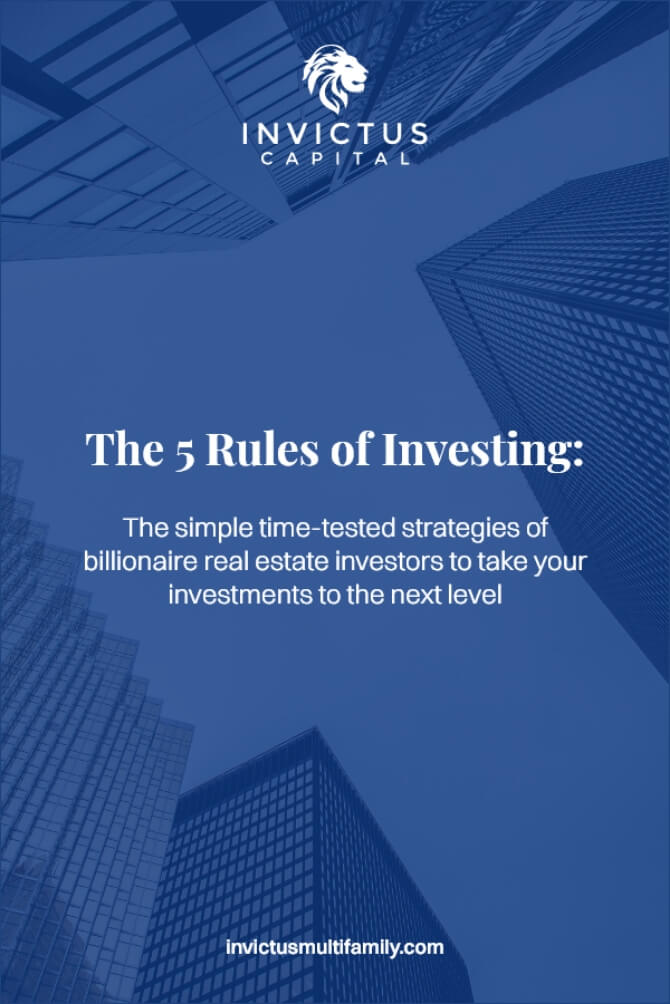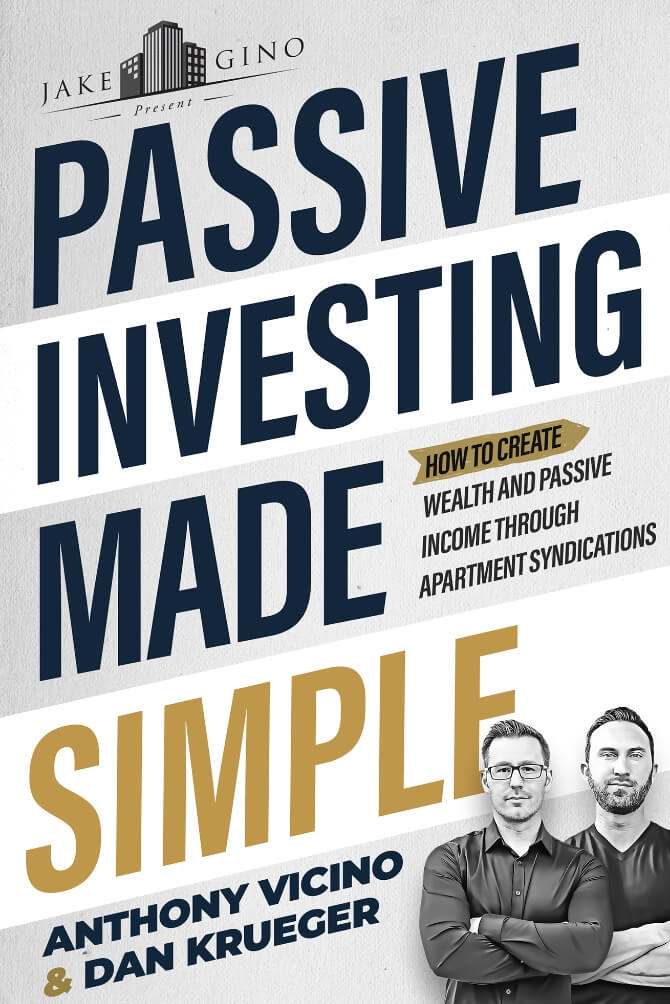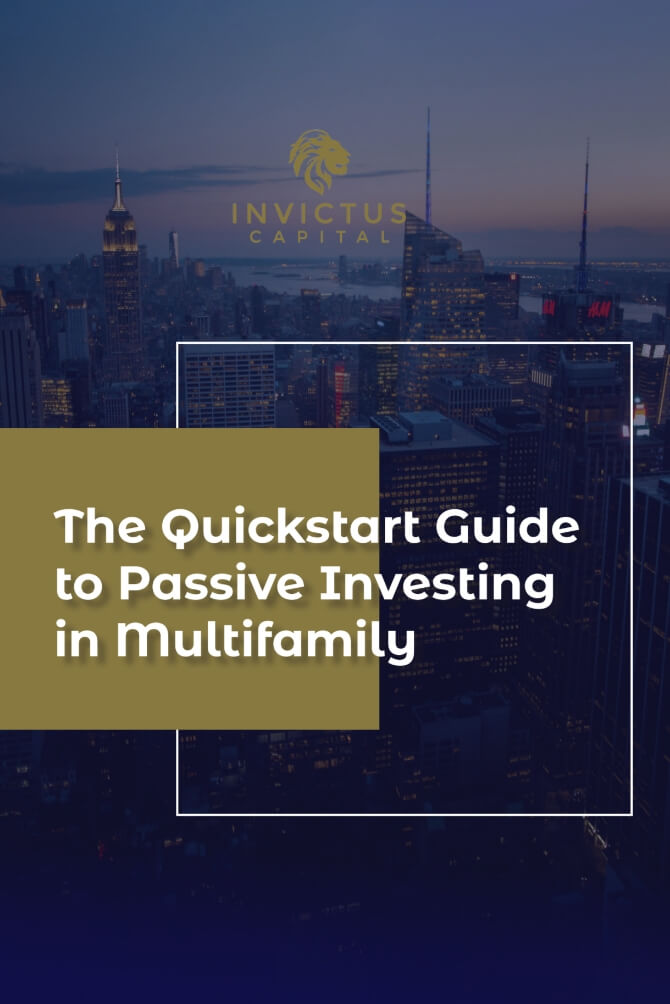For today’s episode, we will be discussing capital stack aka cap stack.
We will go over how the deal is capitalized.
We will talk about these things…and more in another episode of Multifamily Investing Made Simple in under 10 minutes.
Tweetable Quotes:
“as you go up the stack away from that foundation, as you mentioned, you’re less secure…. as to go up that stack the cost of capital increases as well” – Dan Kreuger
“the really important thing to think about when it comes to the stack is literally thought about the foundation, which is the debt, or the person who has a lean on the property – Anthony Vicino
“is a vertical of two structures, debt, and equity” – Anthony Vicino
LEAVE A REVIEW if you liked this episode!!
Keep up with the podcast! Follow us on Apple, Stitcher, Google, and other podcast streaming platforms.
To learn more, visit us at https://invictusmultifamily.com/
**Want to learn more about investing with us?**
We’d love to learn more about you and your investment goals. Please fill out this form and let’s schedule a call: https://invictusmultifamily.com/contact/
**Let’s Connect On Social Media!**
LinkedIn: https://www.linkedin.com/company/11681388/admin/
Facebook: https://www.facebook.com/invictuscapitalventures/
YouTube: https://bit.ly/2Lc0ctX

The Capital Stack Part One
Anthony Vicino: [00:00:14] may beHello and welcome to multifamily investing made simple in Under Ten Minutes, this is the podcast we take the complexity out of real estate investing so that you can take action today. And on this day of days, you’re going to do that by talking about the capital stack. We’re going to do a very special thing over the coming weeks. We’re going to break down the capital stack in ever greater detail. This is a concept that may be a lot of investors aren’t so familiar with. If you’re a passive investor, maybe you’ve never even heard this term. You have no concept for it. So we’re going to explain it from a high level in this episode. And then over the coming weeks, we’re going to go into each of the four different elements that comprise the capital stack and talk about it in more detail. But before we even do that, let’s just take a moment, Dan, to throw our hands up in the air like we just don’t care and celebrate for a moment, because this morning we close on another deal. So let’s just take a moment and kind of do like the Kermit the Frog crazy arms in an area like.
Dan Krueger: [00:01:10] I just moved my bike,
Anthony Vicino: [00:01:13] Just go and get that out of the way. Give the people what they want. Give them the president. There he goes. He’s going crazy people. So real quickly, before we get into today’s episode, just give me 30 seconds of how you’re feeling after the closing today.
Dan Krueger: [00:01:28] Very good. Very good. It was one of the more fun closings because one of our partners on this deal was his first multifamily syndication. They did. And so he kind of pulled out all the stops we had. This is our buddy, Joe. We’re going to have him on at some point here to chat about this deal. But, yeah, we had a photographer come in to snap some pictures, mimosas, and there were mimosas and donuts, which I think you were the only one.
Anthony Vicino: [00:01:54] I was the only one that partook in the donuts. But we all took the mimosas
Dan Krueger: [00:01:59] And the rest of us were rude. And you were the only polite one
Anthony Vicino: [00:02:02] Is always fun. It was fun because all of our closings are usually dry affairs. Like it’s not a big deal. Like you’re signing some paperwork, taking on a whole lot of debt, like getting some keys to a building. And so it’s kind of cool to see somebody who is, like, so excited. It definitely was like, oh, yeah, we should be excited about this.
Dan Krueger: [00:02:20] Yeah, it was fun. It was a lot of fun. But this one was great. I mean, it just everything went smooth, kind of the polar opposite to the last deal that we did that had a lot of twists and turns leading up to the closing table, which we just did a great episode on which we can link to in the show notes. But this one was just so simple. There were no twists, no turns. Everything just kind of happened as it should, which is kind of rare in real estate, I think. I mean, usually, something ends up being slower or more expensive or there’s usually some kind of unexpected thing that pops up. But this one that really went smooth
Anthony Vicino: [00:02:56] Sailing from beginning to end. And we’re going to go into great detail about that deal on next week’s episode of the podcast. So make sure to tune in for that as we do a deep dive into that opportunity because it was really cool. Like the story is not nearly as dramatic as Charles Avenue, which had a couple of twists and turns, but it’s still a really cool story. It was a good time. So enough of that time to get focused, time to provide some value to the dear listeners at home on the treadmill or on their NORDER tracks. So, Dan, what is the capital stack? Let’s break down this concept, because it’s actually really important to understand how real estate deals are structured from a very core level. Like the question was always follow the money. And that’s really what the capital stack allows us to do. Let’s follow the money.
Dan Krueger: [00:03:41] Yeah. So the capital stack is a term that is really heavily used in the private equity world and kind of been the Wall Street circles and something that sophisticated and experienced investors are probably aware of. At least I’ve heard it. But the average Joe, who’s just kind of investing in mutual funds, maybe they’re thinking about getting into real estate, the term capital stack or cap stack is effectively confused. They don’t know what it is. And it’s just a fancy word of saying how is this deal capitalized? Meaning you find a building for ten million dollars, you want to buy it. How is that what makes up that ten million if you were to just take some cash on your bank account because you’re Bezos and you just have tons of capital available and you went and bought it in cash, then your capital stack would be a hundred percent cash? That is your stack. Most people, when they go buy some real estate, will at least get a mortgage. And this applies to you on a house that you bought. So let’s say you see a three hundred thousand dollar house that you want to buy and you’re going to put twenty-five percent down and the rest is coming from a mortgage. That means the capital stack is going to be seventy-five percent debt in twenty-five percent equity. That’s your stack debt and then equity on top. Essentially that’s a stack of things. There are two things there. It’s very simple, but that’s a capital stack. So it can get much more complex the more exotic deals to get. But we’re going to dive into what the real estate syndication capital stacks will typically look like.
Anthony Vicino: [00:05:11] And the really important thing to think about when it comes to the stack is literally thought about the foundation, which is the debt, or the person who has a lean on the property or has a contingency in place. Like the most secure position is typically the foundation, and that’s usually the bank, the bank that’s giving you the mortgage. They have rights that, hey, if you don’t pay your bills, we’re going to come and take that property from you. So that’s very, very highly collateralized. It’s usually the most secure place on the stack. And as you go higher in the stack, things get a little bit less secure. And so at the top of that stack, if this was just a stack of debt and equity, let’s say we brought two hundred fifty thousand dollars to the table, we loaned seven hundred fifty thousand dollars from the bank in the form of debt. So that’s our capital stack. Just two things, which means at the top of that stack, we get paid the equity. Only when the debt first gets paid and so that’s in its simplest model, is a vertical of two structures, debt, and equity.
Dan Krueger: [00:06:13] Another thing dimension, you kind of alluded to it there as you go up the capital stacks. So starting from just your senior basic mortgage on up to whatever’s on top, whether it be equity, preferred equity, mezzanine, debt, whatever, we’ll get into all that and in subsequent sections of this topic. But as you go up the stack away from that foundation, as you mentioned, you’re less secure, which is another way to say that theoretically, the risk profile is starting to increase. And what that also means is that the cost of that capital, whether it be debt or equity, is going to go up. So you’re seeing your mortgage, your foundation, your your your main portion of the stack is probably going to have the lowest cost. So you might get three percent on that. And then if something on top of that, we’re just keeping it really simple and say, let’s just do seventy-five percent debt and twenty-five percent equity-like we always like to do, the cost of that equity is going to be significantly higher than the debt. You’re not going to be paying your investors three percent interest to use their money. They’re going to need something a little bit juicier because of that increased risk that has to go up that the cost of capital increases as well.
Anthony Vicino: [00:07:24] That’s a really good way of putting that so and the following up episodes following weeks, we’re going to be diving into four main components that comprise the stack, and that’s one of the more complicated real estate stocks that you would see. And this could just get broken into like an infinite number of gradations. But if you understand these four concepts, which are senior debt, junior debt or mezzanine debt is another term for that, the preferred equity and equity. So that is if you’re to visualize the stack again, at the bottom is the senior debt. Right above that is junior debt, which will kind of dive into that. So don’t worry about that, guys. From there, it’s preferred equity and then from there, it’s equity. So those are the four concepts that over the next couple of episodes we’re going to dive into each one in isolation. So hopefully this is helpful for you guys. We appreciate you, as always, for taking a little bit of time as your Sladden torso up and down on the NordicTrack
Dan Krueger: [00:08:16] Or everyone is just working out, all
Anthony Vicino: [00:08:19] Because I always hear the feedback that I get from people is like, oh, I was just listening to you on a run. And so I assume everybody I assume our audience is a healthy bunch. I don’t know why, but I assume all of you are out there getting it done with your healthy nuts and your run in and your juices and your cleanses and your fasting and send it regardless of whether you do that or not. We appreciate you for taking some time to join us.
Dan Krueger: [00:08:43] I interpret that as you our concept must be motivating because I know when I’m working out if I’m listening to music, I need to be listening to some kind of information, that energy. So that makes me feel pretty good.
Anthony Vicino: [00:08:54] I have often been compared to Les Brown, so I have never really let you guys go. You’re looking a little sweaty, a little tired. So make sure that you go and drop a review. We really appreciate you guys. And remember, we have passive investing made simple the new book coming out hitting bookshelves on August 11th. So put that on your calendar so you can go out and pick up a copy the moment that it drops. Or if you want a free copy, just email me. Anthony Invictus, multifamily dot com. Anthony, just send me a free copy of your book. I’ll leave a review. You do that. We’re going to be a good officers. We’ll see you guys next week.


